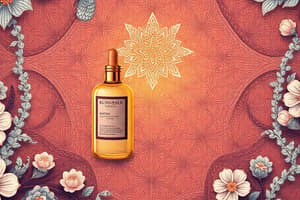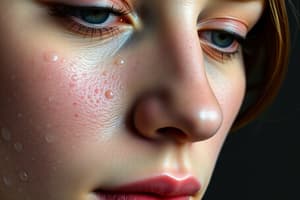Podcast
Questions and Answers
What is a primary ingredient in Calamine lotion?
What is a primary ingredient in Calamine lotion?
- Aluminum
- Zinc Oxide (correct)
- Talc
- Ferric Oxide
Talc is used primarily as a dusting powder.
Talc is used primarily as a dusting powder.
True (A)
What is the role of the skin in relation to pathogens?
What is the role of the skin in relation to pathogens?
The skin serves as the first line of defense against pathogens.
Talc is a native hydrous magnesium silicate with the chemical formula ______.
Talc is a native hydrous magnesium silicate with the chemical formula ______.
Which of the following is a contraindication for the use of certain topical agents?
Which of the following is a contraindication for the use of certain topical agents?
Match the topical agent with its primary use:
Match the topical agent with its primary use:
Calamine is effective for gastrointestinal fistulae.
Calamine is effective for gastrointestinal fistulae.
What is a gastrointestinal fistula?
What is a gastrointestinal fistula?
What is a primary function of protectives?
What is a primary function of protectives?
Intradermal agents are not considered topical.
Intradermal agents are not considered topical.
Name an example of a gastroprotective compound mentioned.
Name an example of a gastroprotective compound mentioned.
The main properties of protectives include being __________ and __________.
The main properties of protectives include being __________ and __________.
What is a disadvantage of some protectives if inhaled?
What is a disadvantage of some protectives if inhaled?
Match the following compounds with their characteristics:
Match the following compounds with their characteristics:
Mouthwash is considered a topical treatment.
Mouthwash is considered a topical treatment.
What is a disadvantage stated for protectives?
What is a disadvantage stated for protectives?
Which of the following agents is used as a disinfectant?
Which of the following agents is used as a disinfectant?
Sterilization ensures that a surface is free from all microorganisms.
Sterilization ensures that a surface is free from all microorganisms.
What is the primary mechanism by which oxidation agents like iodine and chlorine act?
What is the primary mechanism by which oxidation agents like iodine and chlorine act?
An agent that inhibits the growth of microorganisms on living tissues is called an ______.
An agent that inhibits the growth of microorganisms on living tissues is called an ______.
Match the compounds with their mechanisms:
Match the compounds with their mechanisms:
Which of the following is NOT a use of astringents?
Which of the following is NOT a use of astringents?
Chlorine acts by substitution of the chlorine atom for a hydrogen atom in proteins.
Chlorine acts by substitution of the chlorine atom for a hydrogen atom in proteins.
Name one compound used to achieve styptic effects.
Name one compound used to achieve styptic effects.
Flashcards
Topical Agents
Topical Agents
Compounds applied directly to the skin's surface.
Skin's Function
Skin's Function
Skin acts as a primary defense against pathogens and protects the body.
Talc
Talc
A magnesium silicate used as a filtering agent and dusting powder.
Calamine
Calamine
Signup and view all the flashcards
Zinc Oxide
Zinc Oxide
Signup and view all the flashcards
Local Effect (Topical)
Local Effect (Topical)
Signup and view all the flashcards
Fistula
Fistula
Signup and view all the flashcards
Contraindication (Topical)
Contraindication (Topical)
Signup and view all the flashcards
Antiseptic
Antiseptic
Signup and view all the flashcards
Disinfectant
Disinfectant
Signup and view all the flashcards
Sterilization
Sterilization
Signup and view all the flashcards
Oxidation
Oxidation
Signup and view all the flashcards
Halogenation
Halogenation
Signup and view all the flashcards
Protein Precipitant
Protein Precipitant
Signup and view all the flashcards
Astringents
Astringents
Signup and view all the flashcards
Aluminum Salts
Aluminum Salts
Signup and view all the flashcards
Antipruritic
Antipruritic
Signup and view all the flashcards
Gastroprotective Agents
Gastroprotective Agents
Signup and view all the flashcards
Silicon & Polymers
Silicon & Polymers
Signup and view all the flashcards
Chemically Inert
Chemically Inert
Signup and view all the flashcards
Insoluble
Insoluble
Signup and view all the flashcards
Titanium Dioxide
Titanium Dioxide
Signup and view all the flashcards
Aluminum
Aluminum
Signup and view all the flashcards
Study Notes
SKIN - Functions
- First line of defense against disease-causing pathogens
- Protection
TOPICAL AGENTS - SKIN
- Compounds applied to body surfaces.
- Effects are localized (at the application site) or systemic (affecting multiple organs).
- Sheetmasks are considered topical.
- Intradermal agents are not topical.
- Mouthwash is topical.
PROTECTIVES
- Chemically inert
- Insoluble
- Prevent skin irritation
- Difficult to remove
- Applied as dusting powders, suspensions, or ointments.
PROTECTIVE PROPERTIES - EXAMPLES
- Talc: Native hydrous magnesium silicate. Used as a filtering agent, dusting powder.
- Aluminum Oxide: Prevents irritation, protects skin from digestive action of intestinal fluids.
- Calamine: Primary ingredient is zinc oxide, pink color is from ferric oxides, can be phenolated (1%). Used in open wounds/fluid weeping wounds.
- Zinc Stearate: Not wetted by moisture, does not form crusty patches.
- Titanium Dioxide: Can be used instead of talc.
- Aluminum: Reflects UV radiation.
- Silicon Polymer: For wounds discharging large amounts of fluids.
- Simeticone: Used for gastrointestinal issues.
ANTIMICROBIALS
- Antiseptics: Agents that kill or inhibit the growth of microorganisms on living tissue.
- Disinfectants: Agents that destroy microorganisms on non-living objects.
- Sterilization: Completely free of microorganisms.
- Compounds: Examples: Iodine, chlorine, potassium permanganate, hydrogen peroxide. Various mechanisms: oxidative action, reducing groups.
- Halogenation: Use of hypochlorite.
- Protein Precipitation: Examples: Silver, mercury, sulfur. Complexation with proteins can destroy microbes.
Studying That Suits You
Use AI to generate personalized quizzes and flashcards to suit your learning preferences.




